#Sewing machine-
Explore tagged Tumblr posts
Text
"Don't just throw ripped jeans away, you can repair them using these 10 cute Visible Mending techniques!!" unfortunately my friend the first point of failure for every single pair of jeans i have owned in my life has been the Crotch and Ass. Knees: fine, cuffs: fine; but 3 years in, and all that stands between the world and my astronaut-patterned taint is 0.5µm of denim worn so thin that every squat threatens to tear it to shreds like wet toilet paper. If the Tiktok craft community could figure out a way to resurrect jeans afflicted in such a way that doesn't involve adding a whole ass buttpatch like some sort of inverse assless chaps situation then that'd be great
#and yes i have indeed experimented with trying to add invisible patches on the INSIDE of the jean but unfortunately#trying to sew anything to the non-euclidean hellscape that is the crotch area of a pair of pants#inevitably ends up 1. (hand-sewing) puckered as hell or 2. (machine sewing) w me accidentally sewing a leg hole closed 😔
70K notes
·
View notes
Text
How Not to Break Your Sewing Machine
I work in a shop where we repair sewing machines (a LOT of sewing machines), and unsurprisingly we see a lot of the same problems over and over again, so I'm here with some advice on how to keep your machine running longer.

When you break a needle, dig around until you have found the broken piece. If you leave it in there, it can end up in the wrong place at the wrong time and break something vital.
SLOW DOWN. The function of your sewing machine depends on the different moving parts ending up in the right place at the right time. Having to go through a lot of/heavy material slows the needle down, but it doesn't slow down the mechanism underneath the needle plate. If you try to go your usual speed, the needle will arrive too late and collide with something it shouldn't, breaking either the needle or the bobbin case. If the material is especially heavy (say you're sewing several layers of denim, or sewing webbing onto canvas), take your foot off the pedal and turn the machine by hand.
Clean out the bobbin area after each project. Really. Your machine comes with a little brush for this purpose. If it doesn't, a little dollar-store paint brush will work just fine. Remember what I said above about things being in the right place at the right time? Everything needs to be able to move freely for this to work. I know it looks like it's just a little dust and fluff, but it will jam up your machine eventually.
If you can, get your timing adjusted by a professional. I know most people don't have a sewing machine repair shop in their neighbourhood, but if you can do this, it's worth it. If the machine's timing is good, then you're more likely to have a little leeway for heavier fabric or a lintier bobbin case. When the timing is just a bit off, it takes less of an obstacle to put the needle in a place it shouldn't be.
If you can, buy a machine built before 1980. If it's still working 50 years after it was made, it's gonna keep working. Those older machines are made with metal gears and therefore weigh a ton, so they're definitely not a good choice if you don't have a permanent setup for your machine, but it means they basically last forever. Newer machines are made with plastic parts, and no matter what you do, they will break.
Don't buy a Singer Heavy Duty. I'm sure those machines have their benefits, but they are absolutely not heavy duty. We repair more Singer Heavy Dutys than any other single model of sewing machine. If you're already stuck with a Heavy Duty, then follow my advice above even more scrupulously, and start shopping around for a replacement if you can. You can get a used sewing machine of better quality for significantly less than a new Heavy Duty.
To keep things working properly, make sure you're:
threading your machine properly
using the right kind of bobbin
adjusting your tension properly
and using the right kind of needle for the fabric you're sewing!
(These things are unlikely to break your machine, but they will keep it from sewing properly.)
Other than that, get your hands on your machine's manual and read it carefully. If you can, bring your machine in for a cleaning and adjustment now and then. Your machine will need repairs every once in a while: it's a lot of little moving parts! But these are some basic precautions you can take to avoid some common problems.
#sewing machines#sewing#sewblr#sewing machine#i imagine most of you already know this stuff#but many of our customers do not#sewing machine psa#sewing machine maintenance
8K notes
·
View notes
Text
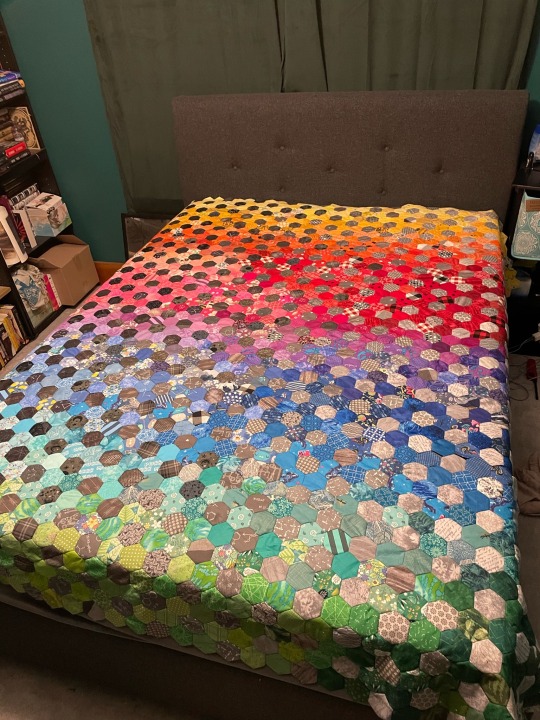
Quilt update. This is split somewhere in the blues and I have to sew that together and then I have to add one more yellow row to the top. Then the quilt top is finally, finally done.
#dear god this has been a journey#I started buying material and making hexagons out of circles last July so it’s been a year and some change#it’ll be over a year and a half by the time I’m finished probably because I’m spending October writing#so I’m waiting until November to find the time and space to actually quilt this thing#and im doing that entirely by hand too#I may bind it with my sewing machine though because holy hell#my quilt#quilt progress
5K notes
·
View notes
Text
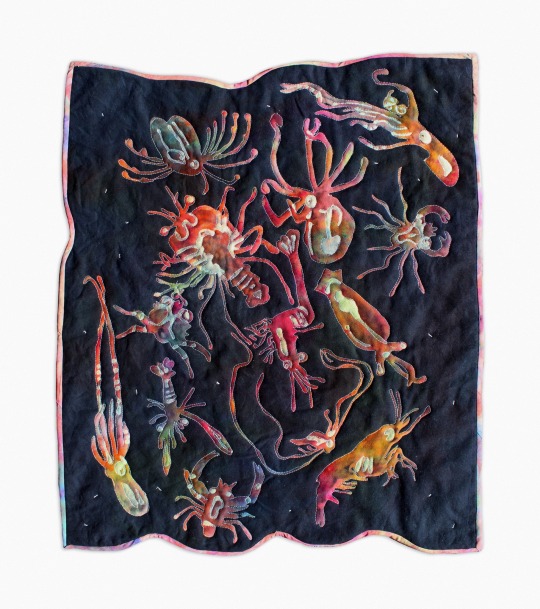
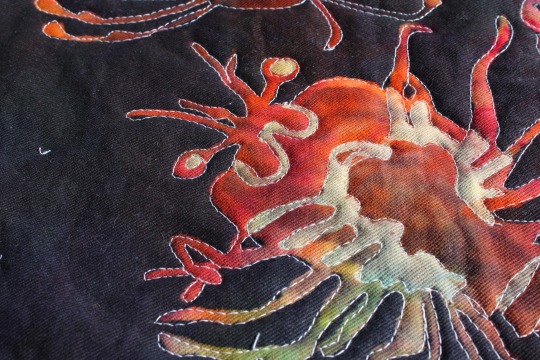
Blackwater Dive
2024, hand bleached and dyed denim, cotton batting and thread
inspired by blackwater photography of plankton! this was my first time layering bleach painting. All the silhouettes were painted with bleaching gel, loosely tie dyed, and then bleached again to make the highlights. I quilted the piece using my free motion foot to outline each individual animal and tacked down the rest of the quilt with small satin stitches that remind me of marine snow. I dyed bias tape to match. super happy with this one and excited to show it in a gallery setting soon!
#my art#queer artist#fiber art#quilt#plankton#marine biology#art#hand dyed#bleach painting#quilting#sewing#sewing machine#shrimp#crustacean#cephalopod#squid#crab#lobster
14K notes
·
View notes
Text

Now, this is different- a skeleton sewing machine for your goth or Halloween decor. I couldn't find it on Google, but I have been told that it's been seen at JoAnn Fabrics.
25K notes
·
View notes
Text



This rocking chair made from an old sewing machine is really cool!
6K notes
·
View notes
Text
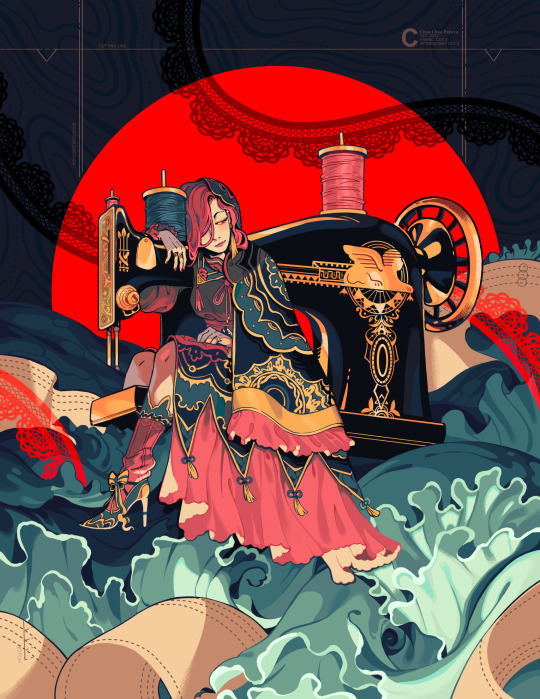
Fabric Obsessed Witch
24K notes
·
View notes
Text
Of course Eliot knows how to sew, between his military service, medical skills, and the likelihood that he's slept with a seamstress or two. He can, at minimum, hem a pair of pants and do most types of repairs.
Hardison, though? Sure, word of God is that he makes the disguises that the team uses during cons, which could just mean he's ironing "FBI" transfer letters onto windbreakers.
HOWEVER.
Hardison is a cosplayer in the early 2010s. I did my first con cosplay at AnimeNext in '08. Before 2013 or so, you could not Google a character and find sales listings for a ready-made cosplay. If you wanted to cosplay a character who doesn't wear readily available normal clothes, you had two options: you either found someone who could sew and were very, very nice to them, or you learned how to make stuff yourself. I know several people who taught themselves how to sew by taking apart thriftstore finds for cosplay, and I had a side hustle taking on sewing and patterning commissions.
Hardison could have commissioned his first cosplay, but I think he'd get sucked in. He'd get really excited about computerized sewing machines. He'd get himself a machine that he can hack and reprogram so it's got extra stitches, multiple buttonhole settings, automatic seam guidance, a controlled heat setting that does a fused edge finish on synthetic fabrics. He digitizes his own embroidery patterns.
At some point Eliot asks to borrow a sewing machine because his job is as rough on his clothes as it is on his body, and he nearly has an aneurysm trying to do a basic darning patch on Hardison's beeping whistling computer-monster. A couple days later, a second sewing machine shows up. It's an old one with sturdy metal innards and mechanical dials to set stitch length and width. It has no screen, no control buttons, and only a handful of settings. One of them is a darning stitch.
1K notes
·
View notes
Text
Why "Universal" means "Equally bad."
So you go to the store to buy needles for your sewing machine. You are going to find one of two things: a few "Universal" needles, or a large section with dozens of needle types.
"None of these say my machine brand on them," you think. "What do these numbers mean?"
I'm here to help you out!
It turns out that needles for sewing machines have amazing specialties to help make the work easier.
Ball point/Jersey: these needles have a rounded 'ball' point so that they don't accidentally cut the threads in a knit fabric. Ever cut a thread in a sweater? We don't want that to happen in a knit fabric either. Knits are used for t-shirts, Sweatshirts and the like.
Sharp/Microtex Sharp: My Beloved. If you sew on any woven fabric, and see "puckers" along your seam, you're not using a Sharp needle. Developed for micro-textiles, these are brilliant for printed quilting cotton, satin, woven silk, and the like.
Jeans/Denim: larger eye, bladed tip. The Sharp is a stiletto; a Denim needle is a sword. The bladed tip makes it easier for your machine to power through densely woven fabrics like canvas, upholstery fabrics, brocade, and old-fashioned denim.
Stretch: this needle is designed to sew on Elastic fabrics with minimal skipped stitches. Spandex and Lycra can stretch so well that they're carried by the needle into the bobbin area of the machine, preventing the stitch from completing. Stretch needles pass through the fabric easier without punching holes.
Quilting: Yep! There's a needle for this! Great for piecing, these really shine while sewing through the layers of fabric and batting. They make free lotion quilting a lot easier, and you won't have to fiddle with the tensions as much!
Leather: perfect for Vinyl, pleather 'vegan' leather, actual leather, and suede, this needle is like a Denim needle with a twist; a twisted blade, that is. It makes a perfectly round hole to prevent the dreaded "Tear along the dotted line" effect.
Metallic: yes, all needles are made of metal, but this type is gentle to metallic threads for decorative work.
Topstitch: this needle has an extra large eye and groove to accommodate heavier threads. Great for high-contrast visible topstitching with heavier threads.
There are others, but this is a good place to start. "Universal" needles don't have any of the specialized features listed above. They aren't sharp, aren't ball-pointed either. They have an average sized eye and groove.
They will sew. They will form a stitch, and they can be a lifesaver when you're not sure what kind of needle to use because you're sewing with more than one challenging fabric simultaneously. However, they aren't "good at" anything. They're kind of "equally bad" at everything.
Do yourself and your sewing machine a favor: Use the right needle for the right project.
One final pro tip: change your needle every 8 hours or so of actual sewing, or at the beginning of every major project.
2K notes
·
View notes
Text
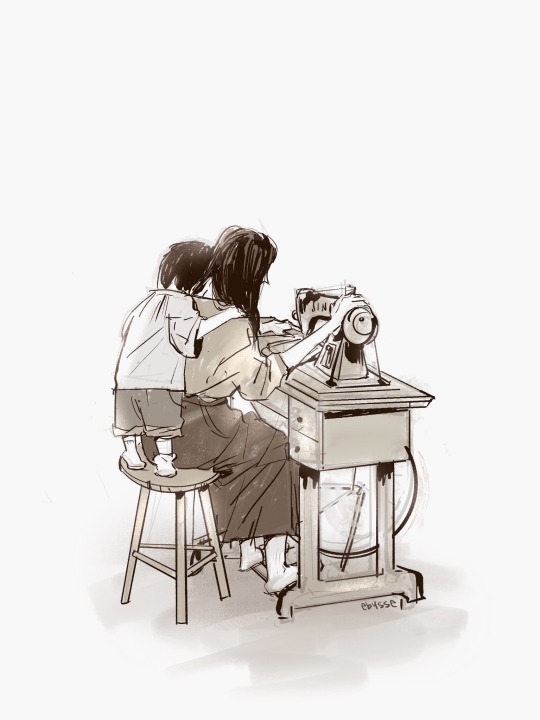
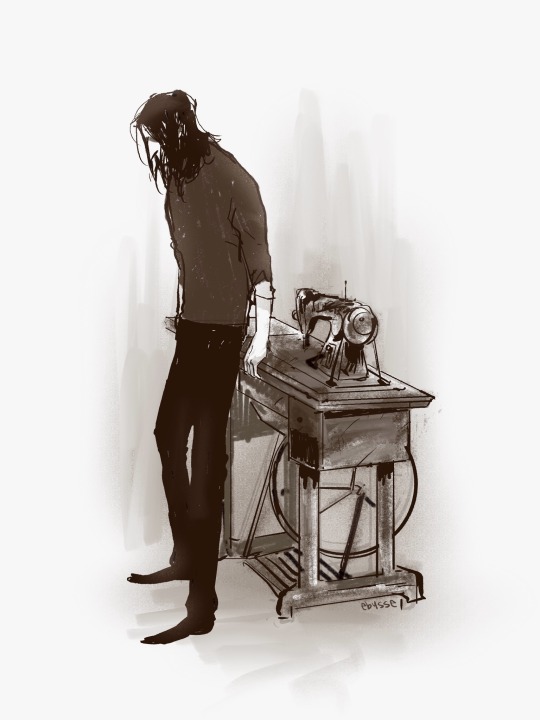
ma’s old singer
#severus snape does not like mothers day#but hope yall had a good one!#(so i absolutely love vintage sewing machines i own 3 and here is fanart of em#theyre such beautiful machines and yet always look somewhat melancholic?? do u kno what i mean do u see the vision#severus snape#eileen snape#eileen prince#snape#hp fanart#mine#PS I WISH I HAD ALL THE TIME TO DRAW#employment is evil actly
4K notes
·
View notes
Text
fun game! mutuals what would you do with $250 000 that wasn’t paying a ticket to get in a giant tin can to see an underwater mass grave?
18K notes
·
View notes
Text
My new theme song
2K notes
·
View notes
Text










My uncle's friend asked if I wanted this machine that he has no use for, and yes I very much did want it, so now I have a beautiful crusty old friend to clean up!
I've never sewn on a White before, but from what I've read online they're very good. Quite a bit different from the Singers I'm used to though. The hand wheel moves in the opposite direction.
It was manufactured in the U.S. (more specifically - Cleveland, Ohio) sometime around the mid 1880s. I'm told it hasn't been used since about the 1970s, but that it used to belong to a woman who made her living by sewing on it for many years.
There's a lot of gunk and old dust to remove, and I need to shorten the drive belt and probably replace the rubber ring on the bobbin winder, but the moving parts are already spinning very smoothly and quietly so I'm hoping it won't be too much trouble.
2K notes
·
View notes
Text
#polls#i wish i knew how to use a sewing machine but i don’t have access to one and can’t afford one :/
4K notes
·
View notes
Text
Follower Kallamar Plushie I made some months ago but never posted😓
I might change his bandages to kelp so he’s not permanently bleeding





I got sick today, and rn I’m just cuddling with him. What a squid, favorite guy. Shoutout to him.

#Favorite Bishop frfr#Was too stubborn to learn how to use the sewing machine so I hand sewed him#Belugh#sicky#kallamar#cotl bishops#cult of the lamb#Plushie#fanmade plushie#follower kallamar#Bishop Kallamar#cotl#cotl kallamar#cult of the lamb kallamar#I took this picture of him and it turned out so cute
2K notes
·
View notes